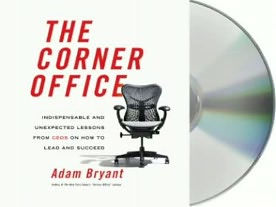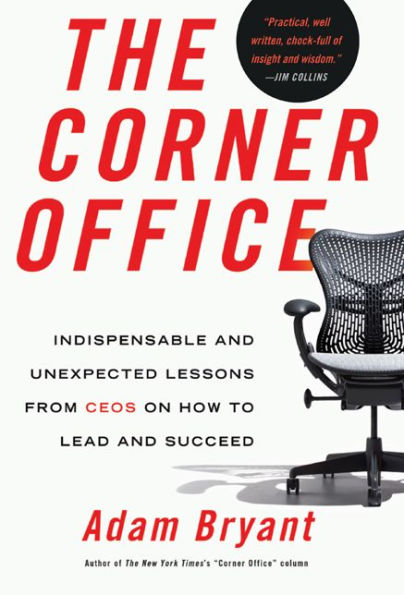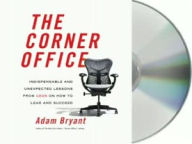
The Corner Office: Indispensable and Unexpected Lessons from CEOs on How to Lead and Succeed
272
The Corner Office: Indispensable and Unexpected Lessons from CEOs on How to Lead and Succeed
272Hardcover(First Edition)
-
SHIP THIS ITEMTemporarily Out of Stock Online
-
PICK UP IN STORECheck Availability at Nearby Stores
Available within 2 business hours
Related collections and offers
Overview
Dozens of top CEOs reveal their candid insights on the keys to effective leadership and the qualities that set high performers apart
What does it take to reach the top in business and to inspire others? Adam Bryant of The New York Times decided to answer this and other questions by sitting down with more than seventy CEOs and asking them how they do their jobs and the most important lessons they learned as they rose through the ranks. Over the course of extraordinary interviews, they shared memorable stories and eye-opening insights.
The Corner Office draws together lessons from chief executives such as Steve Ballmer (Microsoft), Carol Bartz (Yahoo), Jeffrey Katzenberg (DreamWorks), and Alan Mulally (Ford), from which Bryant has crafted an original work that reveals the keys to success in the business world, including the five essential personality traits that all high performers exhibit—qualities that the CEOs themselves value most and that separate the rising stars from their colleagues. Bryant also demystifies the art of leadership and shows how executives at the top of their game get the most out of others.
Leadership is not a one-size-fits-all skill, and these CEOs offer different perspectives that will help anyone who seeks to be a more effective leader and employee. For aspiring executives—of all ages—The Corner Office offers a path to future success.

Product Details
| ISBN-13: | 9780805093063 |
|---|---|
| Publisher: | Holt, Henry & Company, Inc. |
| Publication date: | 04/12/2011 |
| Edition description: | First Edition |
| Pages: | 272 |
| Product dimensions: | 6.10(w) x 9.40(h) x 1.10(d) |
About the Author
Adam Bryant is the deputy national editor of The New York Times and writes the popular "Corner Office" feature in the paper's Sunday Business section. He was the lead editor for the team that won the 2010 Pulitzer Prize for national reporting and is a former senior writer and business editor at Newsweek. He lives in Westchester County, New York.
Read an Excerpt
Introduction
For investors and business journalists, stock-price fluctuations and quarterly results offer a steady stream of report cards for evaluating a CEO's work. And then, every spring, when proxy season rolls around and companies disclose the compensation packages for top executives, another round of report cards begins. This transparency keeps people honest and creates a relatively level playing field (except, of course, when the numbers lie). From these data, a story line emerges around the CEOs as strategists, and we focus on their successes, their failures, their challenges. Have they sized up the industry landscape correctly and developed a plan to beat their competitors? Are they executing this plan in a disciplined fashion?
For this book, I was interested in pursuing a different story line about CEOs—their own personal stories, free of numbers, theories, jargon, charts, and with minimal discussions of their companies or industries. I wanted to hear what they had learned from their ups and downs, their stories about how they learned to lead, the mistakes they made along the way, how they fostered supportive corporate cultures, and how they do the same things that every other manager does—interview job candidates, run meetings, promote teamwork, manage their time, and give and get feedback.
While setting overall business strategy is certainly an important part of a CEO's job, leadership shapes every part of their day. Once they have a plan, the challenge becomes making sure they have the right people on the team, and getting the most out of them and the broader organization. CEOs may not study leadership in books or develop new silver-bullet theories, but they are experts in leadership because they practice it daily. And many of them have spent the better part of a decade or more honing their leadership styles, through trial and error, studying what works and what doesn't, and then mentoring others.
CEOs have learned firsthand what it takes to succeed and rise to the top of an organization. From the corner office, they can watch others attempt a similar climb, and notice the qualities that set people apart. As they evaluate talent, they learn to divine why one person is more likely to succeed than another. When they bring in talent from the outside, they watch as some new hires blend in better than others. Who succeeds? Who fails? Why? It's a feedback loop that expands with every additional person they manage, creating a kind of laboratory for studying the qualities that enable people to succeed. CEOs study team dynamics, too. If one division or group consistently outperforms another, why is that? What leadership skills does that division or group leader possess? Finally, there is feedback from the marketplace. In business, there are constant judgments and scores. From quarter to quarter, CEOs can determine whether their strategies and leadership styles are working, and whether they need to be adjusted.
CEOs face criticism from many corners, and it is often deserved. But there is no arguing that they have achieved a great deal, through a combination of smarts, hard work, attitude, and commitment. They have much to offer beyond a return on a shareholder's investment.
I have spent much of my two decades in business journalism interviewing CEOs and asking variations of the question "What's the strategy for your company?" But I found myself growing more interested in asking them questions like "How do you do what you do?" "How did you learn to do what you do?" and "What lessons have you learned that you can share with others?"
I developed an appreciation for what effective leadership can mean for a company—and the skills a CEO brings to the table—when I covered the airline industry in the mid-1990s as a reporter for the New York Times. It was a particularly turbulent time in the business, and some of the executives running the carriers were larger-than-life characters. The airline industry, I realized, was like the National Football League. There are team colors and logos—and people have strong passions about which teams they love and hate. Each team has roughly the same equipment, and, as in football, the playing field is reasonably level. One airline can instantly copy an effective strategy from a competitor, whether it's a fare sale or a new twist to the frequent-flyer program. Like defensive and offensive players in football, the employees of each airline are organized into their own specialized units—pilots, flight attendants, mechanics, baggage handlers, gate agents, white-collar workers. I found that what really made the difference from one airline to another was leadership. The culture and tone started at the top, and each company reflected the personalities of its CEO, whether it was Robert L. Crandall at American, Herb Kelleher at Southwest, Stephen M. Wolf at United, or Gordon M. Bethune at Continental. The leader who understood how to get his employees to work together as a team had an advantage.
Gordon Bethune in particular faced a difficult challenge in 1994 when he took over Continental, which had made trips through bankruptcy court and had become a punch line for airline jokes on late-night television.
He figured out a simple plan about what mattered to customers, and promised to share rewards with the entire workforce if they hit certain performance measures better than their competitors. He believed that the additional revenue from pulling away premium customers from Continental's competitors and the reduced costs from a better on-time record would more than justify the cost of paying out some of the benefits to workers.
"What you measure is what gets accomplished," Bethune told me during one of several conversations we had in the mid-1990s. "Most businesses fail because they want the right things but measure the wrong things, and they get the wrong results."
Bethune was fast on his feet with expressions that crystallized a problem or question. He didn't apologize, for example, for bringing in high-priced talent from the outside to join his management team. "Now you can hire a brain surgeon, or you can hire a proctologist at half-price who wants to learn," he said. He invested in better service and employee morale instead of single-mindedly cutting costs. "You can make a pizza so cheap, nobody will buy it," he was fond of saying.
He understood that basic ideas were reliable tools, and his turnaround success at Continental brought credibility to his keep-it-simple approach. No jargon, no theories. Just memorable insights and stories from a CEO that had the ring of truth.
"If you say three things in a row that make sense, people will vote for you," he said.
And one good story about leadership and management from an executive who has worked hard to learn it is equal to ten theories about what should be or could be done in a certain situation.
I discovered over the course of in-depth interviews with more than seventy CEOs and other high-ranking executives that they all have remarkable stories to tell, filled with insights and lessons for others. I've studied the transcripts for patterns and connections, and organized them into the chapters that make up the three parts of this book: "Succeeding," "Managing," and "Leading."
My goal is not only to offer a new story line about CEOs as managers but also to provide some back-to-basics help for managers at all levels of business, particularly since so many of the grand notions about transformative business practices have failed to live up to their billing amid the rubble of the busted economy. Employees have higher expectations of their employers now, too, and the companies that can engage them deeply will win the battle for talent.
To be sure, not all CEOs are successes, and a falling stock price can be a sign of an executive out of his depth rather than a lesson in adversity that will make the CEO, and his company, stronger in the long run.
But after interviewing dozens of executives, I was reminded of the first line of Leo Tolstoy's Anna Karenina: "All happy families are alike; each unhappy family is unhappy in its own way." Many of the CEOs I interviewed resembled one another in their approach. They listen, learn, assess what's working, what's not and why, and then make adjustments. They are quick studies, and they also tend to be good teachers, because they understand the process of learning and can explain what they've learned to others. They seem eager to discuss their hard-earned insights rather than hold on to them as if they were proprietary software.
They shared many of the same notions about leadership and management. They put a premium on direct and frank communication, and flattening the organization. They try to use questions more than statements, so that their employees take ownership of their roles rather than simply take orders from the CEO. They provide a sharp contrast to command-and-control leadership styles of the past, when CEOs isolated themselves from employees—literally, in some cases, with a private elevator down to a reserved parking space, and in more subtle ways. Now they want to mix it up. "I love that people push back on me, and it gets to better ideas," said Sheila Lirio Marcelo, CEO of Care.com. "I'm really focused on pushing people to gain the confidence to logically debate with a CEO."
Many successful CEOs reward honesty and input, and show their interest in learning what others think, by holding town-hall meetings, seeking the advice of people at all levels of the company, and asking employees what they would do if they were in charge. "The best ideas or important ideas or new ideas can come from anywhere in an organization," said Tim Brown, the CEO of the design consulting firm IDEO, recalling how a boss valued his opinions when Brown was in his early twenties. "So you'd better do a good job of spotting and promoting them when they come, and not let people's positions dictate how influential their ideas are."
These CEOs also try to create a culture of learning in their organizations, so that, collectively, employees can adjust to the constant changes and challenges of business. The global business environment requires collaborative learning. No single person has the answer anymore, and smart companies try to harness the multiplier effect of bringing people together to share their unique experiences and perspectives on a problem.
"I like building teams with people who come from very different backgrounds and have very different experiences," said Susan Docherty, a vice president of General Motors. "I don't just mean diverse teams, in terms of men and women or people of different color or origin. I like people who have worked in different places in the world than I have, because they bring a lot more context to the discussion. That's something that I value a tremendous amount. I make sure that when I'm looking at people for my team, it's not just what's on their résumé—their strengths or weaknesses or what they've accomplished—but it's the way they think. I can learn twice as much, twice as quickly, if I've got people who think differently than I do around the table."
This book is meant to be that metaphorical table, at which dozens of CEOs, from vastly different backgrounds, countries, and industries, share their insights on how they lead and manage and the best lessons they've learned. These executives don't live up to their own ideals every day—nobody does—and at times some of them have fallen well short. But that doesn't diminish the value of their specific insights or the benefits from hearing them discuss their goals for their companies, and for themselves as leaders. The conversations that inform this book are a kind of time-out from the weekly churn of business—earnings, strategy statements, PowerPoint presentations, SEC filings—and are designed instead to reveal more about CEOs as people, not just as the faces of their companies.
In the chapters that follow, I have tried to play the role of dinner-party host, encouraging lively discussion and pointing out connections among the people gathered. My goal is to frame the conversations but not to dominate them, and to let the people around the table share their stories in their own voices. It's not just what they say that's important—how they say it is revealing, too.
Everybody will read this book differently. Some passages will resonate more than others, and some readers will connect more closely with the experiences and insights of certain executives. That's the nature of collaborative learning. There is no single way to lead or to manage. We all have to figure out what makes sense on our own, and develop our own story lines as leaders. The insights offered by the CEOs in these pages can help speed the learning process for those coming after them and offer fresh approaches to peers looking for new ideas. It doesn't have to be so lonely at the top, or during the climb along the way.
Excerpted from The Corner Office by Adam Bryant
Copyright 2011 by Adam Bryant
Published in 2011 by Times Books, an imprint of Henry Holt and Company
All rights reserved. This work is protected under copyright laws and reproduction is strictly prohibited. Permission to reproduce the material in any manner or medium must be secured from the Publisher.
Table of Contents
List of Interviews xi Author’s Note xv Introduction 1
Part One Succeeding
1. Passionate Curiosity 11
2. Battle-Hardened Confidence 24
3. Team Smarts 40
4. A Simple Mindset 52
5. Fearlessness 62
6. Preparation, Patience, and Obstacle Courses 69
Part Two Managing
7. The Surprises That Await You 87
8. Time Management 97
9. Bananas, Bells, and the Art of Running Meetings 107
10. Smart Interviewing 120
11. Lock Yourself Out of Your Office 138
12. Be a Coach, Not a Critic 152
Part Three Leading
13. Creating a Sense of Mission 167
14. Small Gestures, Big Payoffs 181
15. Type A to B 191
16. Creating a Culture 201
17. So What Is Leadership? 224
Acknowledgments 237
Index 239
Related Subjects
Videos





